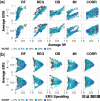Network inference performance complexity: a consequence of topological, experimental and algorithmic determinants
- PMID: 30932143
- PMCID: PMC6748731
- DOI: 10.1093/bioinformatics/btz105
Network inference performance complexity: a consequence of topological, experimental and algorithmic determinants
Abstract
Motivation: Network inference algorithms aim to uncover key regulatory interactions governing cellular decision-making, disease progression and therapeutic interventions. Having an accurate blueprint of this regulation is essential for understanding and controlling cell behavior. However, the utility and impact of these approaches are limited because the ways in which various factors shape inference outcomes remain largely unknown.
Results: We identify and systematically evaluate determinants of performance-including network properties, experimental design choices and data processing-by developing new metrics that quantify confidence across algorithms in comparable terms. We conducted a multifactorial analysis that demonstrates how stimulus target, regulatory kinetics, induction and resolution dynamics, and noise differentially impact widely used algorithms in significant and previously unrecognized ways. The results show how even if high-quality data are paired with high-performing algorithms, inferred models are sometimes susceptible to giving misleading conclusions. Lastly, we validate these findings and the utility of the confidence metrics using realistic in silico gene regulatory networks. This new characterization approach provides a way to more rigorously interpret how algorithms infer regulation from biological datasets.
Availability and implementation: Code is available at http://github.com/bagherilab/networkinference/.
Supplementary information: Supplementary data are available at Bioinformatics online.
© The Author(s) 2019. Published by Oxford University Press.
Figures








